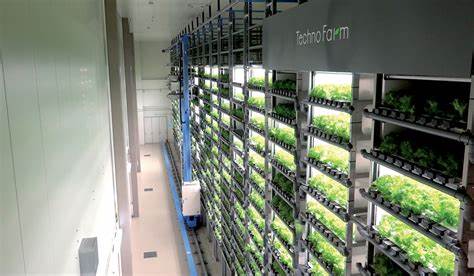
Vertical Farming: Reshaping Perceptions of Agriculture
Introduction
Vertical farming is a revolutionary concept in modern agriculture that has the potential to transform the way we grow and consume food. By utilizing vertical space and employing advanced technologies, vertical farming offers a sustainable and efficient solution to address global food security challenges. In this article, we will explore the historical background, key concepts, benefits, technological innovations, and sustainable aspects of vertical farming. We will also examine case studies, current trends, challenges, and controversies surrounding this emerging industry. Finally, we will speculate on the future implications and applications of vertical farming in reshaping perceptions of agriculture.
Historical Background
The concept of vertical farming can be traced back to the early 20th century, when Professor Gilbert Ellis Bailey first proposed the idea of “skyscraper greenhouses.” However, it wasn’t until recent decades that advancements in technology and urbanization paved the way for the rise of vertical farming. With the advent of controlled environment agriculture (CEA) techniques, such as hydroponics and aeroponics, vertical farming became a viable solution for year-round crop production in urban areas.
Key Concepts and Definitions
Vertical farming involves the cultivation of crops in vertically stacked layers, making efficient use of limited space. It relies on controlled environments, where temperature, humidity, lighting, and nutrient levels are precisely regulated. Hydroponics, a soilless cultivation method, is commonly used in vertical farming, where plants receive nutrients through water solutions. Aeroponics, on the other hand, involves misting the plant roots with nutrient-rich water. Artificial lighting systems, environmental controls, and nutrient management are crucial components of vertical farming, ensuring optimal plant growth and productivity.
Main Discussion Points
Benefits of Vertical Farming
Vertical farming offers numerous advantages over traditional agriculture methods. By utilizing vertical space, it allows for higher crop yields per square foot of land, making it an efficient solution for addressing the increasing demand for food. Moreover, vertical farming reduces water usage by up to 90% compared to conventional farming methods, as water is recycled within the system. Pesticide usage is also minimized due to the controlled environment, contributing to a more sustainable approach to farming. Additionally, vertical farming can mitigate the impacts of climate change and natural disasters on agricultural production, as crops are sheltered from adverse weather conditions. By growing produce closer to urban centers, transportation costs and food waste are reduced, making it an environmentally friendly solution.
Technological Innovations in Vertical Farming
Automation and robotics play a crucial role in vertical farming operations. Drones are used for monitoring crop health, identifying pests, and optimizing resource utilization. Data analytics, machine learning, and artificial intelligence algorithms are employed to monitor and adjust environmental parameters in real-time, maximizing crop growth and minimizing resource consumption. The integration of renewable energy sources, such as solar panels and vertical wind turbines, allows vertical farms to operate sustainably, reducing reliance on fossil fuels.
Vertical Farming and Sustainable Agriculture
Vertical farming aligns with the principles of sustainable agriculture and the circular economy. By recycling water and waste materials within the system, it minimizes resource wastage and creates a closed-loop production cycle. Moreover, vertical farming reduces the need for deforestation, as it can be implemented in urban areas, repurposing existing infrastructure. By minimizing carbon emissions from transportation, vertical farming contributes to the reduction of greenhouse gas emissions and helps combat climate change.
Case Studies or Examples
AeroFarms, located in New Jersey, is a prime example of a successful vertical farming project. They utilize advanced aeroponic technology to grow leafy greens and herbs, achieving remarkable productivity and resource efficiency. Sky Greens in Singapore is another noteworthy example, employing a vertical farming system that utilizes rotating shelves to maximize sunlight exposure for optimal crop growth. These case studies demonstrate the economic viability and scalability of vertical farming, inspiring confidence in its potential to revolutionize agriculture.
Current Trends or Developments
Recent advancements in vertical farming technology have led to its integration in urban skyscrapers. These vertical farms are designed to meet the increasing demand for fresh produce in densely populated cities, reducing transportation costs and ensuring food security. The emergence of vertical farming startups and the growing investments in this sector indicate a promising future for the industry. Furthermore, vertical farming is being integrated into smart city initiatives and urban planning, showcasing its potential to create sustainable and self-sufficient urban ecosystems.
Challenges or Controversies
While vertical farming holds great promise, it also faces certain challenges. High initial capital costs often pose a barrier to entry for aspiring vertical farmers. Additionally, vertical farming requires significant energy consumption for lighting, climate control, and other operations. The nutritional quality and taste of vertically farmed produce compared to traditional farming methods is a subject of debate, requiring further research and development. Furthermore, concerns about the scalability and long-term sustainability of vertical farming need to be addressed to ensure its viability on a larger scale.
Future Outlook
The future of vertical farming is filled with exciting possibilities. It has the potential to play a critical role in space exploration and colonization, where traditional farming is impractical. Vertical farming can revolutionize food production in areas with limited arable land or harsh climates, ensuring food security for future generations. However, further research, innovation, and collaboration are essential to optimize vertical farming practices and make it economically viable on a larger scale. With continued advancements in technology and increased awareness of sustainable farming practices, vertical farming is set to reshape perceptions of agriculture in the years to come.
Conclusion
Vertical farming is a game-changer in the field of agriculture, offering a sustainable and efficient solution to global food security challenges. By utilizing advanced technologies and innovative farming methods, vertical farming maximizes crop yields, minimizes resource consumption, and reduces the environmental impact of traditional farming. The numerous benefits, technological innovations, and sustainable aspects of vertical farming make it a viable and promising alternative for the future of agriculture. As we continue to explore the potential of vertical farming, we are reshaping perceptions of agriculture, ensuring a more sustainable and food-secure world.